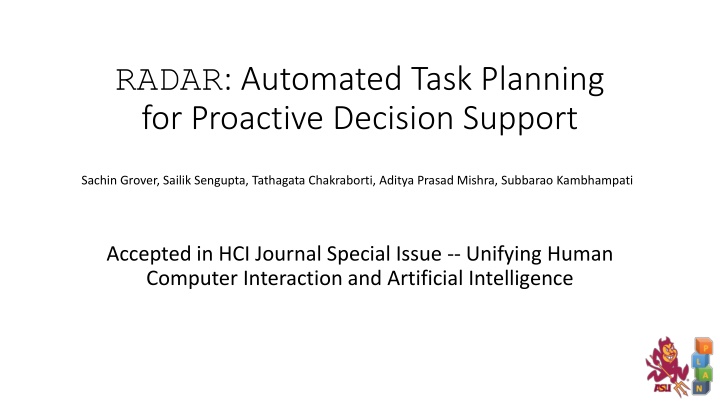
Automated Task Planning for Proactive Decision Support in HCI Journal Special Issue
"Explore the RADAR system that offers automated task planning for proactive decision support, evaluating planning techniques with human studies. Discover how this system aids in decision-making in time-critical scenarios like fire emergencies. Dive into the four stages of decision support and the RADAR system interface, enhancing situational awareness and offering domain independence. Evaluating with students as expert stakeholders brings a new dimension to system testing and improvement."
Download Presentation

Please find below an Image/Link to download the presentation.
The content on the website is provided AS IS for your information and personal use only. It may not be sold, licensed, or shared on other websites without obtaining consent from the author. If you encounter any issues during the download, it is possible that the publisher has removed the file from their server.
You are allowed to download the files provided on this website for personal or commercial use, subject to the condition that they are used lawfully. All files are the property of their respective owners.
The content on the website is provided AS IS for your information and personal use only. It may not be sold, licensed, or shared on other websites without obtaining consent from the author.
E N D
Presentation Transcript
RADAR: Automated Task Planning for Proactive Decision Support Sachin Grover, Sailik Sengupta, Tathagata Chakraborti, Aditya Prasad Mishra, Subbarao Kambhampati Accepted in HCI Journal Special Issue -- Unifying Human Computer Interaction and Artificial Intelligence
Objective There is a need for planners as decision support systems for humans doing the plan steering. Planners have been used on their own, and we know about the feasibility of these human-in-the-loop scenarios, the effectiveness of planning techniques have never been tested with human-studies. In this presentation we describe our work to evaluate these techniques and for decision support.
Proactive Decision Support There is a fire in a building. Fire Marshal the user has to create a plan for Time critical scenario Overwhelming due to sensitivity of the situation Fire Marshal has to maintain complete situational awareness.
Four stages of Decision Support Acquire User Domain represented using PDDL Model Acquisition Plan Summarization using Landmarks Model Updates using Explanations Plan Validation techniques like VAL Information Analysis Plan Correction step by step plan correction Action Suggestion top K plan Monitoring Plan Generation evaluate for optimality and user preferences. Decision Selection Action Execution Different Stages of Decision Support Usage of Planning Technologies
RADAR System Interface Panel 1 shows actions that Fire Marshal can take and the plan being discussed. Panel 2 The goal state Panel 3 Map for the situational awareness Panel 4 Resources available to further help the situational awareness.
RADAR as a Service Domain Independence It is hard to evaluate as these systems can only be tested by the stakeholders .
Evaluation Students as Expert Stakeholders Interface capabilities Initial State Students action Panel Student s Plan of Study
Conditions -- Based on System Capabilities Ccontrol Neither Validation nor suggestion available C1 Validation available C2 Suggestion available C3 Both Validation and Suggestion Available
Study Setup & Hypothesis User study was conducted with 56 students (14 in each condition). Students were selected on first come first serve basis, in response to a department wide e-mail. Every student had to make iPOS for two different initial states. After constructing the iPOS students had to answer set of objective questions. [H1] Planning technologies improve performance [H2] Planning technologies improves interaction with the system [H3] Planning technologies help improve times for new users.
Results [H1] Improves Performance in time Time taken to construct an iPOS for each condition during different runs. We see statistically significant results for C3 compared to all other conditions. But results were not significant to distinguish between validation and suggestion conditions.
Results [H1] Improves User Satisfaction We see an increase in number of users who were satisfied in control condition compared to every other condition. Infact, we saw a positive shift for every condition.
Results [H2] Time decreases for iPOS construction Results show that there was a decrease in time compared to control condition. But among different planning techniques there was no statistically significant difference.
Results [H3] Time improvement for new users The results show that planning techniques didn t improve the time for the new users. It did improve the perceived difficulty of the task at hand for the new users.
Conclusion Evaluated the effectiveness of planning techniques for providing support in decision making. From the results we found that the validation and suggestion based techniques are particularly useful and the user found them helpful (from subjective feedback). We also believed that the explanation based on model differences were useful, but were not statistically significant as learning accurate model for the user is essential for providing explanations. Thank You!
